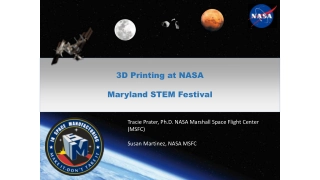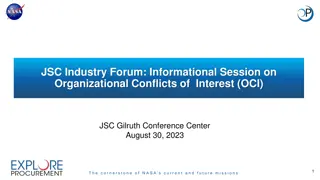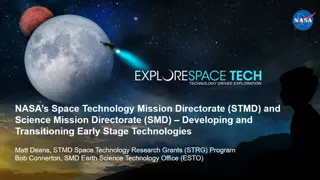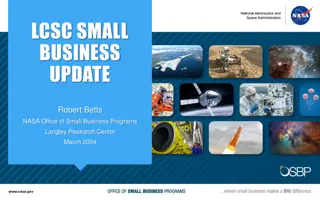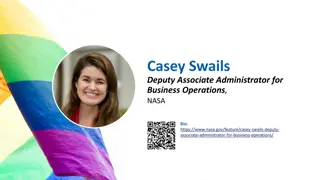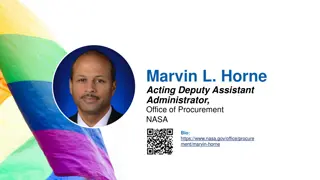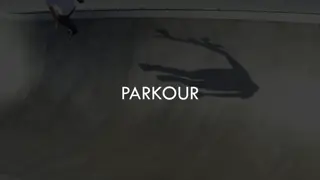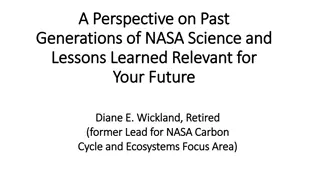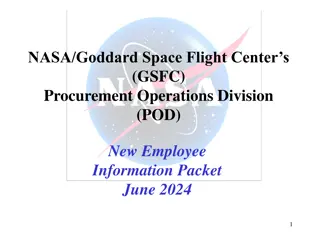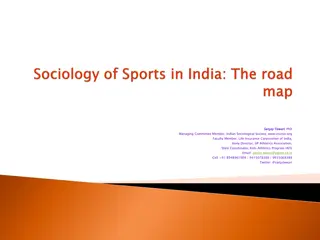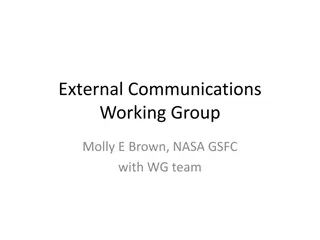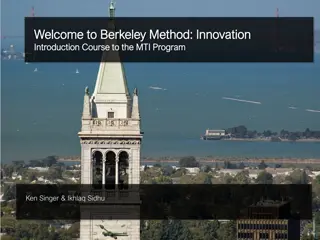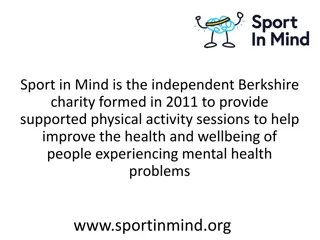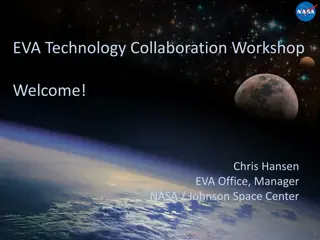NASA SPoRT Partnership and Innovation
NASA SPoRT is recognized for its approachable collaboration and risk-taking culture. The organization is adapting to new project areas while maintaining its expertise in weather-related missions. Emphasis is shifting toward water-related missions, disaster response, and innovative applications like lightning detection. NASA SPoRT is actively involved in expanding its operational capabilities in land surface data assimilation and fostering collaborations for impactful training programs.
Download Presentation

Please find below an Image/Link to download the presentation.
The content on the website is provided AS IS for your information and personal use only. It may not be sold, licensed, or shared on other websites without obtaining consent from the author.If you encounter any issues during the download, it is possible that the publisher has removed the file from their server.
You are allowed to download the files provided on this website for personal or commercial use, subject to the condition that they are used lawfully. All files are the property of their respective owners.
The content on the website is provided AS IS for your information and personal use only. It may not be sold, licensed, or shared on other websites without obtaining consent from the author.
E N D
Presentation Transcript
NASA SPoRT is to be commended for its: Well-deserved reputation as an approachable and effective partner in R2O transition Culture of innovation and calculated risk taking Courage and transparency in committing to an external review group like the SAC
De-emphasis of current weather-related space missions in next 5 years may threaten long term viability of some traditional SPoRT focus areas, but also offers opportunity to pivot into other promising project areas. Examples include: Water-related missions (GPM, SMAP, GRACE/FO, SWOT) in connection with the National Water Center, including adding value through land surface expertise Atmospheric composition missions Ice missions SAR Earth Venture Emerging services in the disaster response sector.
Land Surface Data Assimilation Collaboration with NWC to couple LIS/WRF-Hydro, integrate other NASA data sets into NWM, and accelerate its operational implementation. Investigations of modeling impact of burn areas on land surface, albedo, feedback on weather/water event evolution and attendant impacts GPM, SMAP flood extent, vegetation anomalies, drought monitoring, cross-calibrated PM BTs, ideal approaches for operational GPM use, impact of SMAP DA on short term forecasts Strengthen direct connections to GSFC LIS team and use a loud voice in connection to the NWC to ensure that the group keeps up with ongoing NLDAS developments, DA development, LSM development, etc.
Lightning applications are a strength of the group, especially those focused on GLM and ISS- LIS Aviation, wildfire initiation, international partnerships for DSS in data sparse areas, physically based LJ algorithm for identifying probabilities of imminent hazardous storms Reconsider use/dependence on LMA and transition focus to spaceborne measurements
Contributing to development and delivery of application-based training, ranging from NWS use of weather satellite imagery and products to collaboration with NASA Applied Sciences training projects (ARSET) Operational Guidance and Mission Critical DSS for Day of Launch Support Early Adopter and Other Innovation Experiments Get onboard as early as possible with missions in early adopter/applications efforts Caveat: Ensure appropriate collaborators are involved in the design and execution of experiments outside SPoRTexpertise (e.g., public health)
Data Display and Visualization Support Stay committed to open, flexible, extensible, scalable, both in AWIPS II & web development Use of RPMs to simplify/automate implementation Extension of these capabilities to new partners, disaster response support (e.g. FEMA, Coast Guard examples) Responsive web development may play a significant role in the applicability to end-users in the field Public outreach component of public interface
Automating Process for Requesting, Pre- processing, and Integrating High-Resolution Imagery into NWS DAT Baseline AWIPS Integrated Training, Framework for Application Library, and Networked User Rating System GOES-R Applications Training RGB, Lightning SPoRTModeling capabilities (NASA input data, MET scripts) to UEMS
Atmospheric Data Assimilation Weather/atmospheric assimilation would require coordination with JCSDA partners, internal personnel development Utilize underused aerosols and chemistry observations in operational applications Evolution of NWP From Limited-Area Models to Global Models with adaptive/non-uniform grids Regional Downscaling of Seasonal Prediction Relationship to SPoRT mission Connection to end user?
QUESTION: Does the existing mission statement accurately define NASA SPoRT s unique niche? IOW, What are its distinctive areas of strength, expertise, and value-added contribution to the R2O transition process? The answer to that question is valuable for deciding what to do AND what not to do.
Refine mission to better reflect unique niche One possibility: focus on becoming thegroup in NASA that identifies the most promising data sets, experimental products, applied research, etc., and shepherds them through the last mile to operations. (primarily projects that fall in TRL 8-9 levels) Develop your elevator speech in case you ever find yourself trapped with a NASA administrator
Thank You So Much for Having Us The Discussion Time was Very Fruitful Both in terms of open and closed door The Energy and Motivation of SPoRT is Refreshing and Encouraging


